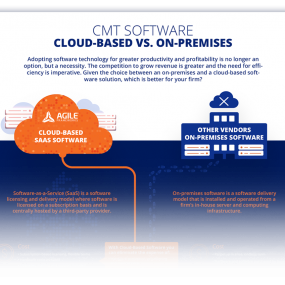Blog
CMT Software Platform: Build or Buy?


Deciding whether you should buy or build a CMT software platform that best fits your needs is a common decision that many construction materials testing and geotechnical engineering firms deliberate.
When making that decision, you must consider that ultimately what you need is a software platform that reduces turnaround time and errors, efficiently manages field and lab resources, automates routine tasks, and helps you seamlessly integrate new technologies and scale up project volume.
The concept of building a solution that is specific to your firm’s workflow can be appealing, but there are several factors to consider when weighing that decision.
The software development cost—whether in-house or outsourced to a third party—can be significant. Dedicating internal resources as subject matter experts for the software development can take valuable resources from your core business and billable tasks.
Even after the CMT software solution is developed, you will need to keep software programming resources on staff or outsourced to maintain, expand, or optimize the software over time.
A multi-tenant Software-as-a-Solution (SaaS) CMT software platform allows for greater investment and innovation as all its customers are making an investment (subscription fee) in the platform for innovation and speed. This pool of “investors” grows as new customers join the platform.
“We don’t have the IT and the infrastructure to house a server and a database to have the security that it needs and the backup. We had experimented before with local IT companies to set up our own program and database. That was a gigantic, 3-year, miserable failure. It didn’t work.”
-- Jenn Smith, CEO, Soil Consultants Engineering
Licensing and hardware costs are another set of required investments for building your own CMT software platform. Your IT team will need to purchase and maintain software licenses and hardware for developing, testing, and QA of the platform. They will also need software tools to manage code and integrations that will be made to the platform.
The SaaS delivery model eliminates the need for firms to install and run applications on their own computers or in their own data centers. This eliminates the expense of hardware acquisition, provisioning and maintenance, as well as software licensing, installation and support.
With in-house, customized software, there are no external support teams. This lack of support means an your firm is posed with additional tasks of troubleshooting fixes, disaster recovery, ensuring high availability, training staff and maintaining the software.
To effectively manage software bug fixes and maintenance, your firm will need specialized IT resources. The firm should evaluate the total cost of having specialized resources that are unrelated to your core business operations versus using an outside SaaS vendor.
Under the SaaS delivery model, the vendor is responsible for maintaining the software and upgrading it to ensure it is reliable and meeting agreed-upon service level agreements (SLAs), and keeping the platform and its data secure.
When you consider a CMT software solution, you want a solution that doesn’t just meet today’s needs, but one that can scale with you as your firm grows. This means that your firm will be responsible for maintaining the solution and updating the software features to fit your evolving needs.
SaaS software providers come with highly experienced customer support teams with technical expertise to support construction materials testing and geotechnical engineering firms with implementation, training, consulting and addressing any issues or concerns about the software.
"It felt like an easier and more efficient choice to have a company that owns the software and develops the software have it on site, versus us trying to have to use IT consultants and our own servers and keep all that up. That felt like a much better option for us.”
-- Erin Parrish, vice president administration, Palmerton & Parrish
Given the choice between an on-premises and a cloud-based software solution, which is best for your firm? Find out in this detailed side-by-side comparison. Download the Infographic >

Client demands and market requirements never stop changing. Partnering with a SaaS vendor who innovates means you’ll always have the tools to deliver the best experience to your clients. And you won’t have to take on that burden yourself.
The business model of cloud-based SaaS solution is to have a zero to very low churn of customers. That model requires SaaS vendors to be innovative and anticipatory with customers to ensure continued growth on the platform.
Take a look at what Agile Frameworks’ SaaS CMT software solution—MetaField—can do for you.